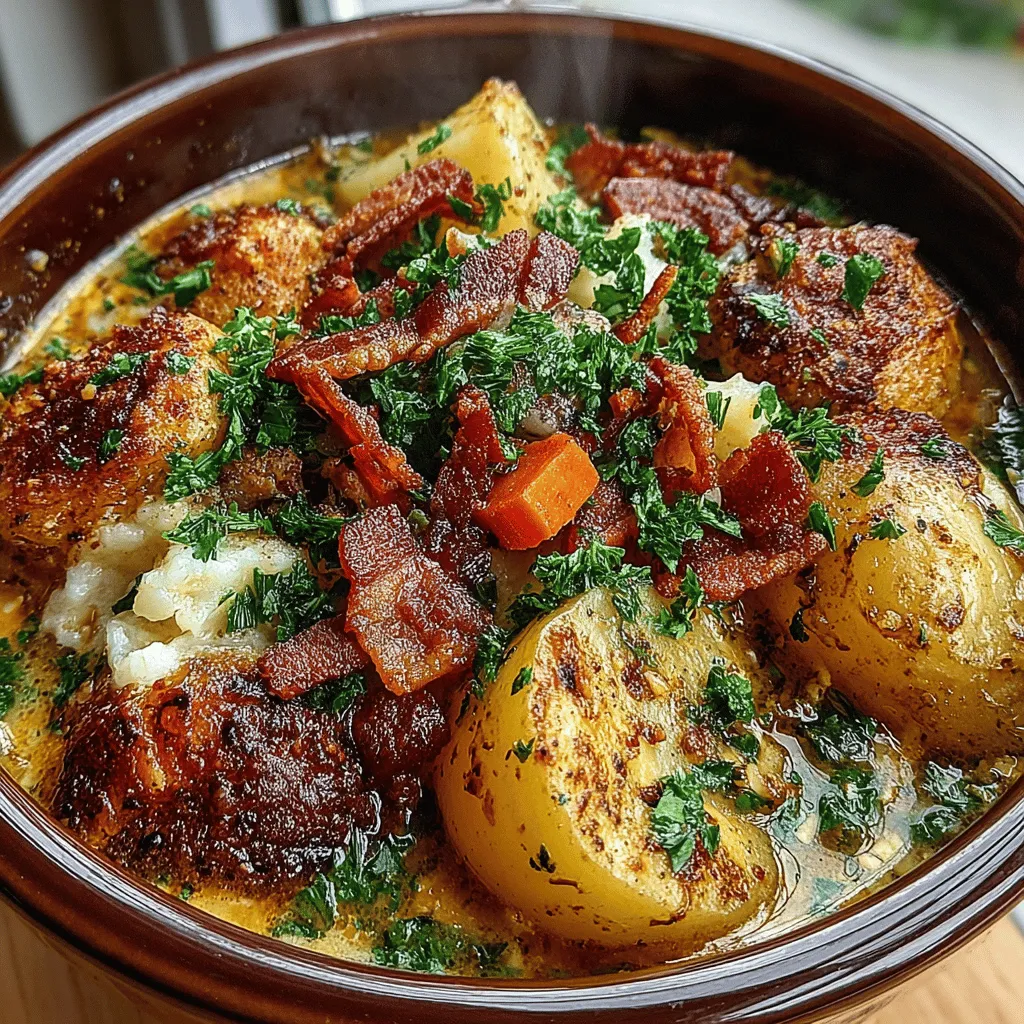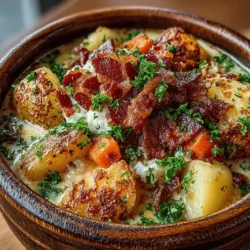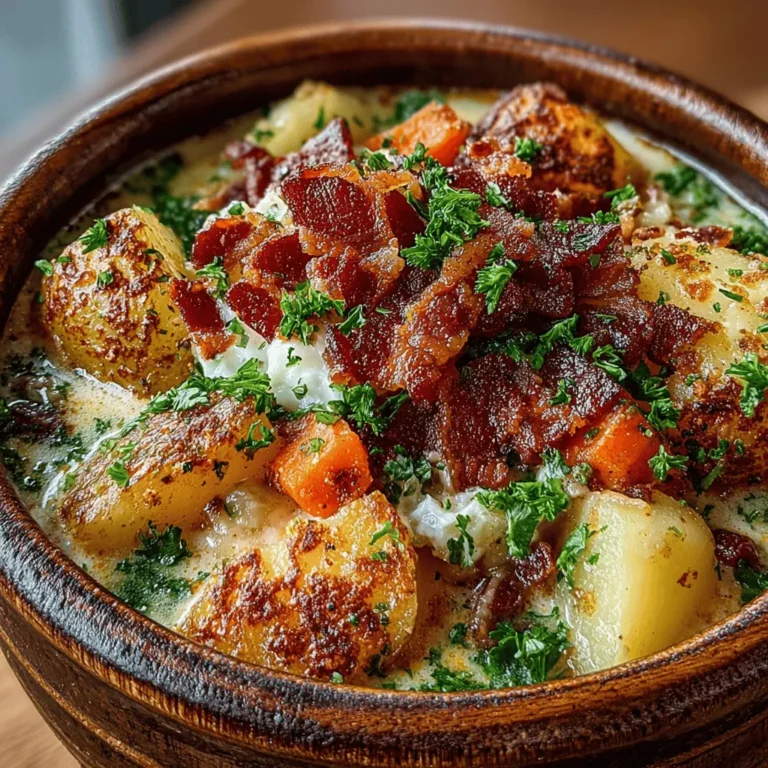New England Comfort in a Bowl: The Ultimate Clam Chowder Recipe
The warmth of New England cuisine is encapsulated perfectly in the delightful dish known as Clam Chowder. This rich, creamy soup is not just a meal; it is a comforting experience that evokes images of coastal towns, family gatherings, and chilly evenings by the fire. Often served in bread bowls or alongside crusty bread, Clam Chowder is a quintessential comfort food steeped in history and tradition. In this article, we will explore the essence of this beloved dish, its cultural significance, and guide you through the initial steps to create your very own bowl of New England comfort.
Understanding the Essence of Clam Chowder
The origins of Clam Chowder can be traced back to the early settlers of New England, who adapted their cooking methods to incorporate the abundant seafood available in the region. While there are several regional variations, the most famous is undoubtedly the creamy, white New England Clam Chowder. This version stands out for its use of milk or cream, creating a rich and velvety texture that perfectly complements the briny flavor of the clams.
Exploring the History of Clam Chowder
Clam Chowder’s history is as varied as the ingredients that go into it. The dish is believed to have descended from a French dish called “chaudière,” which means “cauldron.” As settlers arrived in North America, they combined their culinary traditions with native ingredients, leading to the creation of chowder. Over time, regional variations emerged, with New England’s version gaining popularity due to its creamy base and hearty ingredients.
Traditional New England Clam Chowder typically includes clams, potatoes, onions, and a creamy broth, often flavored with herbs and spices. Each ingredient serves a purpose, not only adding flavor but also telling a story of the region’s fishing heritage and agricultural abundance. The reliance on local ingredients, such as clams harvested from the Atlantic Ocean, has made this chowder a staple of New England cuisine.
The Role of Clams in New England Cuisine
Clams are more than just a key ingredient in this chowder; they are a vital part of New England’s identity. The fishing communities along the coast have relied on clams for generations, and the seafood industry remains an essential economic driver in the region. Clams are harvested from both the ocean and local clam beds, providing fresh, sustainable seafood that is a cornerstone of many local dishes.
In addition to their cultural significance, clams offer numerous nutritional benefits. They are a great source of protein, omega-3 fatty acids, and essential vitamins and minerals, making them not only flavorful but also a healthy addition to your diet. The combination of these nutrients contributes to the comforting nature of Clam Chowder, offering both satisfaction and nourishment.
Ingredients Breakdown for the Perfect Chowder
Creating the perfect New England Clam Chowder begins with selecting the right ingredients. Each component plays a crucial role in achieving the rich flavors and creamy texture that define this dish.
Fresh Ingredients for Optimal Flavor
When it comes to Clam Chowder, the quality of ingredients is paramount. Start with thick-cut bacon, which adds a smoky richness and depth to the chowder. The fat rendered from the bacon is used to sauté the aromatics, infusing the entire dish with flavor. Opt for good-quality, nitrate-free bacon if possible, as it will enhance the overall taste without unnecessary preservatives.
Next, choose the right type of potatoes. Yukon Gold potatoes are a popular choice due to their creamy texture and buttery flavor. They hold up well when cooked and contribute a luxurious mouthfeel to the chowder. Russet potatoes can also be used, but they tend to be starchier and may break down more easily. For a hearty chowder, Yukon Gold is the way to go.
Fresh vegetables, particularly onions and celery, serve as the backbone of the chowder. They not only provide flavor but also texture, adding to the overall experience of the dish. Sauté these vegetables until they are soft and fragrant to create a solid foundation for your chowder.
Dairy Choices: Cream and Milk
The creamy richness of Clam Chowder comes primarily from the dairy ingredients used. Heavy cream is often the go-to choice, lending a luxurious texture and a decadent flavor that makes this chowder a true indulgence. However, if you’re looking for a lighter alternative, you can substitute some of the heavy cream with milk or even a non-dairy option, such as coconut milk, for those who are lactose intolerant.
Finding the right balance between cream and milk is crucial. Too much cream can overwhelm the dish, while too little may result in a watery consistency. A combination of both is often the best approach, allowing you to achieve that perfect creamy texture without sacrificing flavor.
Enhancing Flavor with Seasonings
The magic of Clam Chowder lies not only in its ingredients but also in the seasonings that elevate the dish. Garlic is a must-have for adding depth, while bay leaves impart a subtle earthiness that complements the briny clams. Fresh parsley is a classic garnish that not only adds a pop of color but also brightens up the flavors, making each bite more enjoyable.
When seasoning your chowder, it’s important to taste as you go. The balance of flavors can be adjusted according to personal preference, ensuring that each bowl is tailored to your liking.
Step-by-Step Preparation of New England Clam Chowder
Now that you have a good understanding of the ingredients, let’s dive into the initial steps of preparing this comforting dish.
Preparing the Base: Cooking the Bacon
To start, heat a large pot or Dutch oven over medium heat. Add the thick-cut bacon and cook until it becomes crispy, usually about 6 to 8 minutes. This step is crucial because the rendered bacon fat will serve as the flavor base for your chowder. Once the bacon is crispy, remove it from the pot and let it drain on paper towels, leaving the bacon fat in the pot.
Sautéing the Aromatics: Building Flavor
With the bacon fat still sizzling, add diced onions and celery to the pot. Sauté these aromatics for about 5 minutes, or until they are soft and translucent. This step is vital for building flavor, as it allows the natural sugars in the vegetables to caramelize, enhancing the overall taste of the chowder.
Next, add minced garlic and cook for an additional minute, stirring frequently to prevent it from burning. The aroma of garlic wafting through your kitchen will signal that you are on the right track to creating a delicious chowder.
Simmering the Chowder: Achieving the Right Consistency
Once your aromatics are perfectly sautéed, it’s time to add the key ingredients: diced potatoes, chopped clams, and the clam juice or broth. Pour in enough liquid to cover the potatoes and clams, bringing the mixture to a gentle simmer. You’ll want to let this simmer for about 15 to 20 minutes, or until the potatoes are fork-tender.
During this time, the flavors will meld beautifully, and the chowder will begin to thicken. As it simmers, keep an eye on the consistency; if it becomes too thick, you can always add a bit more broth or water to achieve your desired texture.
With these initial steps completed, you will be well on your way to creating a comforting bowl of New England Clam Chowder that evokes the warmth of the coast. In the following sections, we will delve deeper into the finishing touches and tips for serving your chowder to ensure it becomes a favorite in your home.

The Significance of Simmering the Potatoes for Texture
When preparing New England Clam Chowder, the texture of the potatoes plays a crucial role in achieving the ideal mouthfeel. Simmering the potatoes until they are just tender allows them to release some of their starch into the broth, contributing to a creamy, velvety consistency without the need for excessive cream.
To achieve this, start by peeling and dicing your potatoes into uniform, bite-sized pieces. This ensures that they cook evenly. Once the potatoes are added to the simmering broth, keep a close watch on them. You want them to be fork-tender but not mushy. Typically, this takes about 10 to 15 minutes, depending on the size of your potato cubes and the temperature of your heat.
Remember, overcooked potatoes can disintegrate and create a grainy texture in your chowder, which is not desirable. Simmering at a gentle heat allows for a gradual release of starch while retaining the potatoes’ shape, resulting in a chowder that is both hearty and satisfying.
Monitoring Heat to Prevent Curdling of Dairy
Another essential step in crafting a perfect New England Clam Chowder is to carefully manage the heat when incorporating dairy products. The creamy richness that defines this dish often comes from heavy cream or milk. However, if these ingredients are added to a boiling pot, there is a risk of curdling, which can ruin the smooth texture of your chowder.
To prevent curdling, ensure that your chowder is on low to medium heat when you add the cream. Stir it in gently, allowing the heat from the chowder to warm the cream gradually. This method not only ensures that the dairy integrates smoothly but also preserves the creamy consistency that is integral to the dish.
Incorporating the dairy toward the end of the cooking process, after the clams have been added, lets you maintain the integrity of the ingredients while achieving that luxurious texture we all crave in a comforting bowl of chowder.
Incorporating Clams: The Final Touch
Timing for Adding Clams to Maintain Their Tenderness
Clams are the stars of this chowder, and timing is everything when it comes to their addition. Fresh clams should be added during the last 5 to 7 minutes of cooking. This brief cooking time ensures that they remain tender and avoid becoming rubbery. If you are using canned clams, these can be added even later, just long enough to heat through, as they are already cooked.
As you stir the clams into the simmering chowder, watch for their shells to open if you are using fresh clams. This is a signal that they are ready to eat. Any clams that remain closed should be discarded, as they may not be safe to consume.
Balancing Seasoning for the Perfect Taste
With the clams added, it’s time to taste your chowder and adjust the seasoning. The natural saltiness of the clams can enhance the overall flavor, but it’s essential to taste before adding any additional salt. Freshly cracked black pepper is also a wonderful addition, enhancing the chowder’s flavor profile without overpowering the delicate taste of the clams.
A splash of fresh lemon juice can brighten the dish and balance the richness of the cream, bringing all the flavors together beautifully. Adjust the seasoning to your preference, but remember that you can always add more salt later, so start with a little and build up as needed.
Serving Suggestions for Ultimate Enjoyment
Choosing the Right Bowls and Accompaniments
The experience of enjoying your New England Clam Chowder goes beyond just taste—it’s about presentation too. Serving chowder in rustic, wide bowls not only enhances its visual appeal but also allows for a generous portion that invites hearty enjoyment. Opt for ceramic or stoneware bowls to create a warm, inviting atmosphere that complements the comfort food vibe of the chowder.
Accompanying your chowder with the right sides can elevate the meal further. Classic accompaniments include crusty sourdough or a warm baguette, perfect for dipping into the creamy broth. A light green salad dressed with a tangy vinaigrette can provide a refreshing contrast to the richness of the chowder, balancing the meal.
Garnishing for Visual and Flavor Enhancement
The final touches on your chowder are just as important as the cooking process itself. Garnishing with freshly chopped parsley not only adds a pop of color but also contributes a fresh, herbal note that enhances the overall flavor. Crispy bacon bits can be a delightful addition, providing a savory crunch that contrasts beautifully with the smoothness of the chowder.
Consider offering optional toppings such as croutons, a sprinkle of Old Bay seasoning, or even a dash of hot sauce for those who enjoy a bit of heat. This allows each guest to customize their bowl, making the meal feel personalized and special.
Exploring Variations of Clam Chowder
Regional Twists on the Classic Recipe
While New England Clam Chowder is a beloved classic, it’s interesting to explore its variations. For instance, Manhattan Clam Chowder features a tomato-based broth, offering a completely different flavor profile. This version is often lighter and utilizes different spices, appealing to those who prefer a more acidic taste.
Creative adaptations can also be made for different palates, such as adding corn for sweetness or using different types of seafood alongside clams for a mixed seafood chowder. These adaptations provide an opportunity to experiment while still honoring the essence of clam chowder.
Vegetarian and Vegan Versions
For those who follow a vegetarian or vegan lifestyle, there are ways to adapt this classic dish without sacrificing flavor. Instead of clams, consider using plant-based proteins such as chickpeas or artichoke hearts to add a hearty texture.
Using vegetable stock instead of clam juice and incorporating dairy alternatives such as coconut milk or cashew cream can create a creamy base that is both satisfying and rich. Seasoning with smoked paprika can help impart a depth of flavor reminiscent of the traditional recipe, making these alternatives just as enjoyable.
The Comforting Experience of Enjoying Chowder
Creating a Cozy Atmosphere
The experience of enjoying New England Clam Chowder can be enhanced by creating a cozy atmosphere. Set the scene with soft lighting, perhaps by using candles or string lights, to create an inviting dining area. Seasonal decorations, such as autumn leaves or a wintery table setting, can also enhance the overall vibe, making the meal feel special and festive.
Pairing your chowder with a warm beverage, such as a spiced apple cider or hot chocolate, can complete the comforting experience, making it a meal to remember.
Sharing the Joy of Chowder
One of the most delightful aspects of chowder is its communal nature. Sharing a pot of steaming chowder with family or friends encourages conversation and connection. Consider inviting loved ones to join you in the kitchen while you prepare the chowder, creating memories as you chop, stir, and taste together.
Serving chowder family-style, with everyone gathering around the table to ladle their own portions, fosters a sense of togetherness that embodies the spirit of this comforting dish.
Conclusion: Embracing Tradition and Flavor
New England Clam Chowder is more than just a recipe; it’s a celebration of tradition, flavor, and comfort. With its rich history and heartwarming essence, this dish brings people together, evoking a sense of home and nostalgia. As you prepare your own bowl of this chowder, you not only savor the delightful taste but also connect with the cultural roots that make it a beloved classic.
Every spoonful of chowder carries a story, a tradition passed down through generations, and the warmth of shared meals. Whether you enjoy it on a cold winter day or as a special gathering dish, each bowl of New England Clam Chowder invites you to indulge in its comforting embrace. Enjoy each spoonful and the comfort it brings, knowing that you are partaking in a cherished culinary tradition that has stood the test of time.


